SOPHIE ROSSITTO news editor
Graduate students began classes at Harding this fall for a new cardiac device technology program, which is the first master’s degree program in the world for this field.
Fourteen students have formed the first cohort of the 10-month Cardiac Function and Interventional Technology (CFIT) program, director Ken Turley said. CFIT assistant professor Tristan Pendergrass said this program allows students to explore the field of cardiac devices such as pacemakers and defibrillators, learn about processes such as cardiac mapping, and learn about complementary areas such as cardiac imaging.
Pendergrass said students who earn CFIT degrees can find jobs in outpatient clinics, in hospital cardiac procedure areas or with device manufacturers. He said those who enter the
cardiac technology field have opportunities to provide life-changing services to people with heart conditions.
“You’re also around these patients in very high-stress, emotionally charged situations, and you’re a third party that has the time to spend with them and their family and answer questions, and kind of be both an advocate and a guide,” Pendergrass said.
Turley said the CFIT program combines classroom courses with hands-on labs, where students can work with devices such as pacemaker simulators and operate on cadavers. They can also gain experience in clinicals at hospitals throughout Central Arkansas.
Pendergrass said the CFIT program began with a boot camp on the week of Aug. 15, and classes started the following week. Harding alumni and cardiac device industry professionals attended a CFIT
kickoff event on Aug. 26 in Cone Chapel, giving students a chance to connect with people from different companies.

Turley said CFIT students come from a variety of academic backgrounds, including exercise science, nursing and psychology. One student in the program, Britton Anderson, said that as an undergraduate at Harding, she was a nursing major for two and a half years before changing her major to business and graduating last summer.
Anderson said she applied to the CFIT program because it combined her interest in pursuing a career in medical sales with her love of interacting with patients.
“It’s just such a cool field that I don’t think people know much about,” Anderson said.
Turley said he first became interested in forming a new master’s program during a Zoom meeting in spring 2021, when a group
of exercise science students talked about two Harding alumni who were working in the cardiac device industry.
Turley said he reached out to Harding administrators and received their support in starting the program. He then worked to find people to teach the technical aspects of the program.

Turley said launching the CFIT program has been challenging because it is unlike any other in the country, so he and his colleagues have had few models to look to for guidance. Turley said Pendergrass and Mark Sweezy, a sponsor for the CFIT program, have played key roles in helping him throughout this process.
“I feel very, very fortunate that God just put a lot of things in place to make all this happen,” Turley said.
Biden announces loan forgiveness plan
President Joe Biden announced a three-part student loan relief plan on Aug. 24, canceling up to $20,000 in student debt for an estimated 43 million people. Those millions include over 35% of Harding students currently enrolled, institutional researcher Dustin Howell said. The White House released a statement describing the plan the same day it was announced.
“President Biden believes that a posthigh school education should be a ticket to a middle-class life, but for too many, the cost of borrowing for college is a lifelong burden that deprives them of that opportunity,” the statement said. “This plan offers targeted debt relief as part of a comprehensive effort to address the burden of growing college costs and make the student loan system more manageable for working families.”
The White House statement cited the economic crisis of the pandemic as the reason behind the decision.
The first step of the plan is extending the pause in loan payments until Dec. 31.
Part two is to provide debt relief. Pell Grant recipients are eligible for up to $20,000 of debt cancellation, while non-Pell Grant recipients may get up to $10,000. Only those who make less than the income cap can receive relief — $125,000, or 250,000 if married. Part three involves an overhaul of the student loan system, proposing a new version of the income-driven repayment plan to reduce monthly payments. The Department of Education is also taking steps to hold accountable colleges that have contributed to an excess of student debt.

Senior Nicholas Emlaw said he will accept any loan forgiveness he is given, but he is uncertain about how the government plans to pay for it.
“Although I’m more than happy to accept the free money… my questions lie in underlying motives,” Emlaw said. “Where the money is coming from.”
Like Emlaw, Chair of the Finance Department David Johnson advised students to make use of the relief money.
“I’d take it, because, you know, it is available to you,” Johnson said. “If you don’t think you should do that yourself, if you wouldn’t feel
right about it, then follow your conscience in that regard.”
In Biden’s address announcing the plan, he cited deficit reduction as to where the money comes from. Deficit reduction is the process of reducing the amount by which a government’s spending exceeds the money it receives in taxes. Johnson said this debt reduction is not the same as having excess funds.
“We had a deficit,” Johnson said. “This is going to be a smaller deficit. That’s not a source of money.”
Jay Simpson, senior associate director of Financial Aid Services, said students should look into their own situations to make sure they get the aid they are eligible for.
“While we all may have our opinions about this news, this is action taken by the president,” Simpson said. “And we encourage student loan borrowers to make sure their contact information is up to date with their loan servicers so that they will receive direct communication about their own situation. Loan servicer information is available by logging into studentaid.gov.”
Enrollment by the numbers
SARA HOOK features/layout editor
CFIT Director Ken Turley speaks at the CFIT program opening ceremony in Cone Chapel on Aug. 26. The first cohort of the 10-month CFIT program was recognized at the ceremony.
Photo by MADISON MEYER
Graphic by COOPER TURMAN
Graphic by
University offers new CFIT program NEWS SPORTS FEATURES LIFESTYLE 2A 3&4A 1&2B 3B 4B OPINIONS Online at TheLink.Harding.edu Searcy, Ark., 72149 A HARDING UNIVERSITY STUDENT PUBLICATION THE THE September 9, 2022 Vol. 98, No. 02 @HUStudentPubs Facebook: Harding University Student Publications
NEWS . . . . . . . . . . . . . . . 2A OPINIONS . . . . . . . . . . 3&4A SPORTS . . . . . . . . . . . . . .1B COMMUNITY . . . . . . . . . . 2B FEATURES . . . . . . . . . . . . 3B LIFESTYLE . . . . . . . . . . . . 4B
EMMA JONES 6.2% 4,804 3.76 amount new student enrollment increased; including 805 first time college students, and 115 transfer students total student headcount Source: Harding University press release from Sept. 6 average high school grade point average of freshman class
‘A living piece of art’ Workers preserve fallen tree on campus

The catalpa tree by Benson Auditorium has been a beloved staple on campus for several decades. On May 19, the tree split in half, yet, in a peculiar turn of events, the tree continues to stand. According to Harding groundskeeper Joe Burton, the catalpa split from natural causes and remains in perfect health.
“It started diverting root resources years ago,” Burton said. “It was a very gradual process, and that’s why it’s growing so vibrantly on both sides.”
As soon as the tree split, conversations about saving it began. Burton said the early stages involved getting permission from the director of physical resources, Danny DeRamus, who decided the crew should add support beams for the tree to rest on. Burton said the crew hopes the tree will start rooting where it contacts the ground, creating a living archway.
Next steps involved cutting back the catalpa’s heavier, more potentially damaging
parts and ensuring the space would be safe for emergency personnel, as well as testing the accessibility for students walking and riding their bikes along the path.
Burton said in the beginning stages, the crew collected seeds and cuttings from the tree and used them to start around 30 new catalpas, which are all growing vibrantly and can replace the parent tree if anything happens. The crew also plans to plant some of these trees around campus.
Junior Baraka Iboo was one of the students on the grounds crew who helped propagate and care for these baby catalpas over the summer. Iboo worked on a farm at home in Tanzania before coming to Harding, and this experience working with the grounds crew has given him an opportunity to expand his skills and learn more about agriculture. Iboo said part of Burton’s decision to save the tree was its history on campus, so it was exciting for Iboo to be a part of preserving it.
“There are some people who really love it because it has been there since they were kids and now they’re in their 70s, in their 80s, and the tree is still there, so [Burton] wanted to
save it,” Iboo said. “It was a great experience because I wasn’t expecting it to stay alive, so once after a while, I saw the tree was not going to die, I was really excited about that.”
Additionally, the crew has several projects planned for the area, including improving drainage and creating flower beds. Burton said he hopes the location will become a place for students to spend time, especially with its proximity to the Student Center.
“This is a kind of iconic tree,” Burton said. “And I think it’s going to continue to be iconic now.”
One person was already using the catalpa for reading before the tree fell — two days before, in fact. Professor of English language and literature Dr. Larry Hunt was on campus teaching an intersession class when he felt moved to read under the tree.
“I’d never read under it because I always felt like I would be on display…since it’s like a hub of people walking,” Hunt said. “But it was summer, and nobody was here, and I thought, ‘I’m gonna go read under the tree.’”
While Hunt was sitting under the catalpa, one of the blossoms fell into the
middle of his book, prompting him to save the blossom. When he finished reading, he said he felt moved to thank God, and the tree, for the experience.
These circumstances repeated for Hunt the next day, from the blossom falling into his book to thanking the tree afterward. The following day, the tree split. Though Hunt was happy to learn the catalpa had survived, he was left to wonder about the meaning behind these events.
“I hope what this means is that God answered my prayer and transformed it into this really cool living arch,” Hunt said. “I mean, I don’t know, he hasn’t told me, but it was just a really cool, very strange experience.”
Burton has also found a spiritual aspect in the new life of this catalpa tree.
“To me, this is just another opportunity to look for spiritual answers to human problems,” Burton said. “It’s basically two trees that hopefully, in this season of its life, just look cool and are like a living piece of art for years to come.”
Power outages affecting White County and Harding University Tuesday, Sept. 6, caused the University to cancel chapel services.
“Once we realized that the power outage was not on campus and was more in the Searcy grid, that definitely helped give some relief because it was nothing to do with [Harding],” Logan Light, assistant dean for Campus Life and Chapel Programs, said.

Light said chapel was canceled to keep students safe.
“In the end, you know chapel is all about shared experience, and this is definitely one of those things that I think students will remember,” Light said.
Students on campus experienced power outages as early as 8:15 a.m., according to Danny DeRamus, director of physical
resources. Harding administrators notified students about the outages via email, text
Entergy Corp. sent an email to White County customers at 8:54 a.m. that said
CIANNA JAY asst. copy editor
English professor Dr. Larry Hunt reads a book by the catalpa tree near Benson Auditorium. Hunt said he first started reading under the tree two days before it split in May.
Graphic by COOPER TURMAN
Photo by MADISON MEYER
Article contributed by ADVANCED JOURNALISM CLASS
Friday, September 9, 20222A NEWS
Thundering Herd head count: marching band by the numbers Harding officials cancel chapel due to power outages Clarinets Sousaphones Trombones Saxophones Trumpets Percussionists Mellophones Baritones Flutes Total: 48Total: 48Drum majors
Should student loans be forgiven?
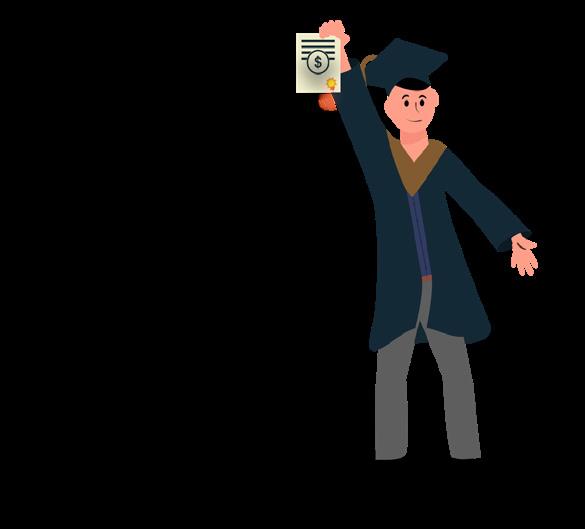
For





Joe Biden’s presidency has been marked by the radical idea of debt relief to help American families recover from the strains of a world rocked by the COVID-19 pandemic.
Forgiving student loans, in theory, would alleviate financial stress on young people who are practically bullied by the baby boomer generation for not being able to afford buying a house or having kids. While unprecedented, more people have student loans right now than ever before. Hopefully, the 45 million Americans with student loans would then be able to give a boost to the economy if unburdened by the average $28,400 debt from college. Here, they would also be able to invest more in their financial future. Since social security is projected to become exhausted by 2037, this would be a helpful tool in securing a financial future.
Society tells people to get educated and get a stable job to climb the socioeconomic ladder and get out of poverty, but this starts the perpetual cycle of accruing more debt through student loans. After accounting for inflation, the cost of college has tripled since 1980. There is an imbalance in logic between the necessity for higher education increasing while the price for this education is ever-increasing as well, making it impossible for people to afford getting a college degree to be able to get a well-paying job — or if they have a college degree, it is impossible to pay off the piles of student loans that are accruing interest.
Alleviating student debt would also help address racial inequality of income, helping advance racial equity. The average White family has about 10 times more wealth than the average Black family, and White college graduates have over seven times more wealth than Black college graduates. What’s more, Black college graduates have lower homeownership rates than White high school dropouts. Cleaning the slate of student loans would give people of color a fighting chance to narrow the racial wealth gap.
My faith is built on a man that took all my debt that I could never afford and paid it before I could even ask. I try to be like Jesus. I hope that the selfless nature of paying someone else’s debt never poses a problem for me. I hope I can look beyond political parties, economics and statistics to see the hearts of people burdened with debt. I think that’s what Jesus would do.
Against
The idea of loan forgiveness on its own seems like it could benefit the public. But just like all things, there is a cause and effect relationship which I believe could make a negative impact that considerably outweighs the positives. As a college student, I make sure to keep in check with my financial aid. I am well aware of all my scholarships, loans and amounts due. I keep up with all of it to ensure I never spend or borrow more than I believe I can pay back. All college students have access to their financial aid and loans. So it’s no surprise when the bill comes due that they have to pay it. All college students are well aware of what they’re getting into.
Another issue is that loan forgiveness may give future students the mindset that whatever they borrow will be forgiven. This could promote reckless borrowing, and plunge students into a deeper hole than they’re already in. If I believed I could spend $20,000 and not be accountable, I would do it in a heartbeat. Now imagine hundreds of thousands of students recklessly borrowing money they can’t pay back. This is asking for an economic crisis. Even so, colleges could raise tuition by $10,000 and put us right back in the same place. Every person making less than $125,000 per year is eligible for this loan forgiveness. That’s over 85% of Americans (Statista.com). That’s a lot of students, with a lot of loans that are simply forgiven. Any economist knows that money never disappears. It will be transferred to be paid by someone else. It’ll most likely be taxpayers who will then be forced to pay for students who have recklessly taken out loans. This money will largely be spent on middle class students. If we were going to mindlessly spend this much taxpayer money, couldn’t we do something more beneficial such as supplying better financial aid to low-income citizens to help make college an option for them?
Though there are many other reasons, this is simply a taste as to why I believe student loans should not be forgiven, especially to this degree.

One thing I will agree with is that college tuition rates are way too high. Although I don’t agree with the particular solution provided, we should be investigating solutions to lower the cost of college. This would help not just the middle class who want college, but it would also appeal to low-income families and provide opportunities for them. High tuition rates are definitely a problem.
Student loan forgiveness just isn’t the solution.
Istanbul not Constantinople
When discussing political leaders, historically or contemporarily, it is important to contextualize in order to understand what makes a leader “good” during a particular time. While our definition of “good” leaders has morphed in recent years, especially in the United States, this was not always the case. Before the advent of European thought throughout the world, a leader was good if he could affirm his legitimacy to the world, provide for his people and dominate militarily. (Of course, I do not intend to stand before you and tell you that this was in any way a desirable system.) All and all, I intend to give you a very brief, not necessarily formal, understanding of the political history of the Ottoman Empire’s best sultan, Mehmed II.
The House of Osman ruled the Ottoman Empire for the whole of its existence, dating from its foundation in 1299 to its disintegration in 1922. Throughout its history, and much like European history, the Ottoman Empire had both good — with an Islamicate Period understanding of the word “good” — and bad leaders. Despite its many contenders, I will still submit that Mehmed II is the greatest Ottoman Sultan, not only for his numerous military achievements but also for his cultural significance throughout both his time and the modern world.
Starting first with his cultural achievements, Mehmed II was uniquely interested in development of the arts and sciences in the Ottoman Empire, especially when considering the broader state of the world in this time period. At the same time that Europe was still clawing its way out of the Middle Ages, Mehmed II was erecting massive monuments, a university, mosques, the Topkapı Palace and the Tiled Kiosk. Mehmed II was also a patron of Renaissance art, commissioning both Ottoman and Mediterranean artists, and further contributing to the spread of cultures between Europe and the Middle East. Furthermore, Mehmed II even assisted the Christian mission by ordering Gennadius, a Byzantine patriarch, to translate many Christian texts to Turkish. Through all of these examples, it is clear that Mehmed II considered cultural significance, promotion of education and enrichment through education as a worthy pursuit of a sultan.
Militarily speaking, Mehmed II had a unique mind for the battlefield and as a result has quite an extensive and remarkable war resume. Most important to Ottoman history was the siege of Constantinople in 1453, two years after Mehmed II’s second ascension to the throne in 1451. Constantinople is arguably the most well-defended city, conventionally
speaking by Middle Ages standards, in human history. Despite that, through his ingenuity, Mehmed II developed a plan to lift Ottoman boats over land to bypass Byzantine defenses and siege the city through the full force of Ottoman naval capabilities. Yet it was what followed this siege — Mehmed II’s claim of the title of Caesar — that shows his cultural and historical understanding of how to gain the approval of one’s citizens, which is of course to claim legitimacy through accessing the past, particularly an idealized past. This is not the first, nor the last time, that someone will claim the title of Caesar, yet despite that, a certain amount of credit must be given to him, as this claim followed the siege of Constantinople.
Mehmed II appealed to the people in a way that no other sultan was capable of doing: through genuine belief in the power of his citizens, and through the understanding of his citizens enough to know they’d need more than just simple divinity to gain their acceptance. Mehmed II built the foundation on which his nation could thrive and did everything in his power to be perceived as a “good” leader for his people.
What’s good
Concerning hobbits
If you’ve read or watched “The Lord of the Rings,” you’ll know that Hobbits are a unique species in J.R.R. Tolkien’s writings. They do not strive for wisdom like the elves, nor do they chase after greed like the dwarves, nor do they lust for power like the humans. Instead, they find joy in working their fields, smoking their pipes and throwing birthday parties. As a third grader, I thought hobbits were overwhelmingly lame, and I would fast forward to when the fighting started at least an hour into the movie. I would replay the battle scenes on repeat so I know Helm’s Deep and Pelennor Fields like the back of my hand. Even when I read the books in middle school and high school, I would shake my fist at the heavens hoping Tolkien would see my boredom while I read his extensive descriptions of trees and Hobbit life. Only within the last three or so years since I’ve taken an honest interest in literature do I understand what was happening.

The boring life of the Hobbit is just that — boring because everything is perfect, and there’s no plot. We suspect that there must be something wrong within this utopia, the Shire, but everything wrong is brought from the outside. In other books, there is an archetype, something like “the warrior in the garden,” who lives in a peaceful place, ready to defend whenever war comes around. Tolkien flips the archetype on its head; he takes four gardeners and sends them to war. Four hobbits who know nothing but the Shire are shipped off to lands of blood and desolation.
Throughout the whole trilogy, the reader or watcher is thinking, “How on Middle-earth does this little good defeat all that evil?” or in the words of King Theoden, “What can man do against such reckless hate?” a question whose answer lies within the Hobbits: Resisting temptation and being humble is enough. Here is why this makes sense: Goodness does not destroy evil in this story, instead, evil corrupts even itself. When Frodo is on the altar of Mount Doom, he does not throw the ring into the fire. He gives into it in the greatest character failing of all romantic literature. Frodo only needs to make it to the altar for Gollum’s evil to plunge them into the fire, and even when Frodo cannot make it that far, Sam carries him.
The beauty of Lord of the Rings is that the tension is not in the battles, but in Frodo’s ability to resist the temptation to take the ring for himself. That is Tolkien’s wisdom: goodness does not prevail from winning wars or tearing down institutions, but from much simpler acts like being gentle and kind. We need only make it to the cross for Christ to protect us from our sin collapsing in on us, and when we cannot even trudge up that far, the Spirit will carry us there.
Emma Jones editor-in-chief
Sara Hook features/layout editor
Sophie Rissotto news editor
Ben Lane sports editor Sierra Tackwell community editor Malachi Brown opinions editor
Maggie Samples lifestyle editor Gabriel Huff head copy editor Cianna Jay asst. copy editor
Emma Weber editorial assisstant Madison Meyer head photographer Balazs Balassa asst. photographer
Macy Cox asst. photographer Gracie Cornett cartoonist Bonnie Spann business manager
Cooper Turman graphic designer Wagner Valdez asst. graphic designer Stacy Roibal beat reporter
Emily Stinnett historian April Fatula faculty adviser Michael Claxton narrative columnist
Emily Stinnett Watkins Kelly Mattie Powers
Carter Tweatt Mitch Friensenborg Gabe Mahon
Ethan Conn Lauren Simmons Anna Claire Williams
Grace Hurt Morgan Wrigley Max De Loach
Gabi Gonzalez
Opinions Editor Malachi Brown
MALACHI BROWN is the opinions editor for The Bison. He may be contacted at mbrown33@harding.edu.
– Malachi Brown, opinions editor
Goodness does not prevail from winning wars.
MAX DE LOACH is a guest writer for The Bison. He may be contacted at wdeloach@harding.edu.
Guest Writer
Max De Loach
Guest Writer
Anna Claire Williams
Guest Writer Gabe Mahon
GABE MAHON is a guest writer for The Bison. He may be contacted at gmahon@harding.edu.
ANNA CLAIRE WILLIAMS is a guest writer for The Bison. She may be contacted at awilliams15@harding.edu.
Graphic by Cooper Turman
Graphic by Wagner Valdez
staff guest contributors
TheLink.Harding.edu OPINIONS 3A
Ten Thousand Words
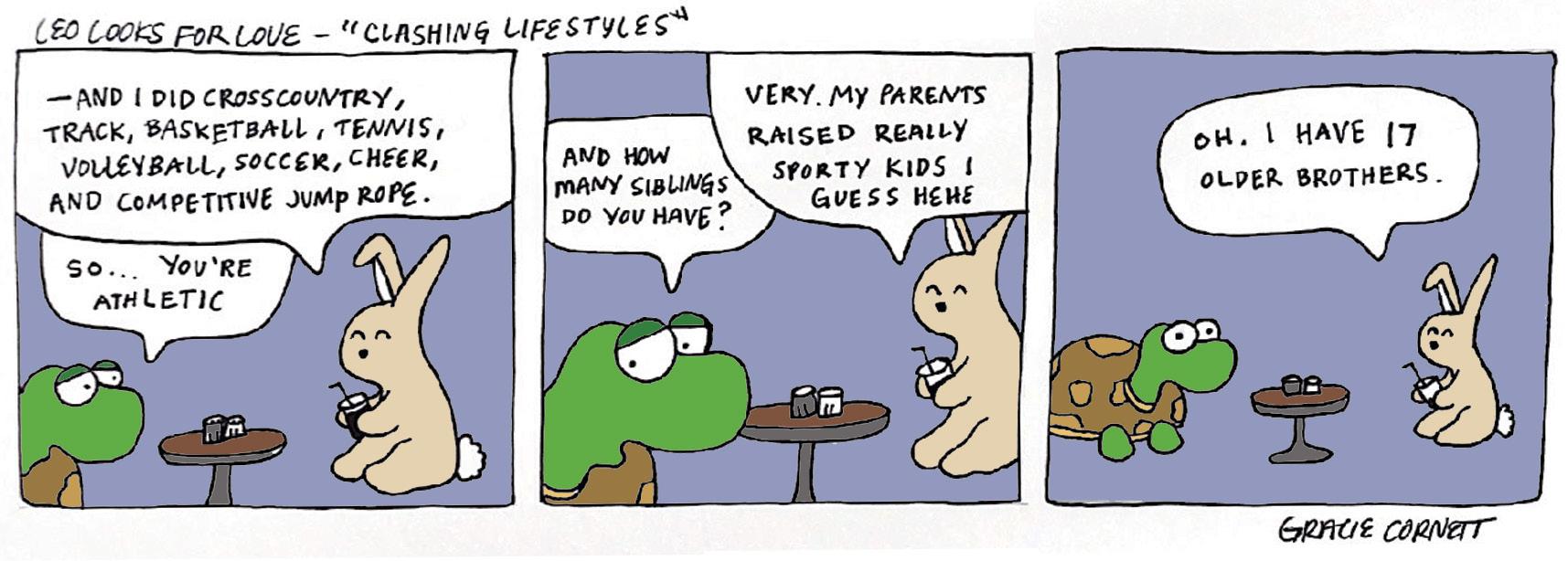
OMW to watch OTGW
Are there any shows or movies that you watch every year for different seasons or holidays? I’m talking “Elf” over Christmas break, “Aquamarine” in the summer or “Stranger Things” season two around Halloween. A personal favorite of mine to rewatch when it’s getting close to fall is the show “Over the Garden Wall.”
OTGW is an animated miniseries that ran for one season on Cartoon Network in 2014. With 10 episodes that are only 11 minutes each, it’s very easy to sit down and just binge like it’s a movie. Inspired by a 19th and 20th century farmland-Americana that’s riddled with fantasy, the show makes for a perfect fall watch with equal amounts of cozy and creepy plotlines.
– Emma Jones, editor-in-chief

Fall has always been my favorite season. In my opinion, nothing else beats its aesthetic or holidays or seasonal activities. This year especially, I have been very ready for summer to end and the days to start getting cooler — I’ve already got my pumpkin-shaped candy jar ready to fill with treats. Fall is such a nostalgic season for me: It’s watching college football with my dad, jumping in huge piles of leaves with my brothers, baking banana bread with my mom and going trick-or-treating with my best friend. Rewatching OTGW each year has become a tradition that gets me prepared for my favorite season, even if the leaves aren’t changing colors just yet.
Everything about this Emmy-award winning show, from the colors to the music to the characters, epitomizes autumn. The animation is done in muted, warm tones of mainly oranges and browns and greens. The soundtrack, based on pre1950s melodies and songs, helps add to the whimsical theme of the series while helping it still feel nostalgic. Even many of the characters are reminiscent of fall, with sentient pumpkins, anthropomorphic woodland creatures and a beast the main characters are warned away from.

Don’t just take my word for it that you should curl up with some popcorn and watch OTGW soon — take science’s. A study from Psych Central has shown that watching shows or movies can help boost your mood, and taking a break from schoolwork for something enjoyable is relaxing and helps ward off potential burnout. Watching something with other people (like your roommate) can also help improve your relationship with them by providing a point of connection. (Not that any of this is much of a surprise — who doesn’t love a good movie night?)
All that being said, if you’re ready for fall to get here and also needing something to watch, I highly recommend “Over the Garden Wall.” It’s available on Hulu, Prime Video and HBO Max. If you do end up watching it, please let me know what you think. I hope it satisfies all your cravings for autumn.
Systemic purity
Beat Reporter Stacy Roibal
A few days before the start of this semester, I got a call from my mom. She wanted to say that she was learning about the toxicity of purity culture, and that she was sorry — sorry for teaching it to me and my sisters. “I wish I could take it all back.” That was her plea, and I accepted her apology. I am very proud of her for having the courage to change her mindset, but the truth is that it’s too late, and she can’t take it back. I have been working at unlearning many skewed ideologies that I was raised on, and I’ve been doing it all on my own for the past three years.
For those not familiar with the term “purity culture,” it stems from an evangelical abstinence movement in the ’90s that sought to suppress sexuality in teenagers and young adults as a response to “too much freedom” (if you will) in decades prior. There were some good intentions, but the waves of negative repercussions are still washing over us today. The problem with suppression is that it generates shame, and in that shame we can begin to see a broken system.
In my opinion, not being “sexually pure” doesn’t alter your value as a human being in any way; however, nobody told me that growing up. There are people who didn’t get to make the choice themselves to stay “sexually pure,” some people gave into pressure, and some people grew tired
of being afraid of the stigma around sex. Whatever your story is — you are immensely valuable and loved by your creator, and that will not change.
– Stacy Roibal, beat reporter
I was taught that my “virginity” was a precious gift that was destined for my future spouse. My value directly correlated with how pure I was. I had to dress modestly so I could protect men from myself, and if they desired me it was my fault. Boys “battle” with lust and girls don’t, so we have to be understanding of them. If I got a boyfriend, we had to set “boundaries” so we could stay righteous before God. Crossing a boundary was something to be completely ashamed of. If I found myself desiring someone, it was because Satan had found his way to my heart — not because it was a normal part of growing up. The list goes on, but what I’m trying to say is that the way in which purity is being taught has been and continues to be harmful.
It should be devastating that this ideology has caused so many young people to resent
themselves, to lose their sense of selfworth, to believe that there is something wrong with them, to feel so much shame for simply being human. If God created me in his image, how come I was taught to resent so many things about that image? And by my church no less — the people who were meant to teach me about love.
I am going to tell you some things I believe, and I hope others in my evangelical community can believe them, too. Remaining “pure” is not the highest thing that someone might achieve in this life. Being the best version of yourself is the greatest thing you can give your future spouse. It is not a woman’s fault if a man desires her. Seriously, can we stop blaming women’s shoulders for causing a man to “stumble”— that is his problem. Your story is important and beautiful, no matter your background. It can be difficult to unlearn things that have been systematically taught, but it is not impossible.
The primary care doctor my mother saw for 40 years in Georgia retired in the spring. He was such a caring physician that mother asked him not to retire while she was still living. He smiled but could not make such a promise. So, we spent much of the summer trying to break in a new doctor. Mom likes him, but, as she says, “It won’t be the same.”
Much of Searcy knows exactly how she feels. While most Harding students were away for the summer, an icon of our school and community passed away, and groups all over town will mourn his absence.
Jim Citty was born in rural Oklahoma. His father died when Jim was very young. When he graduated from high school, his minister suggested he visit Harding. So, with $25 he had earned hauling hay that summer, and with only one pair of jeans to his name, Jim enrolled as a freshman in 1957. A natural athlete, he played basketball and ran track, and when Harding restarted its football program in 1959, Jim became the team captain. He met his wife Maralyn at Harding, and after graduation in 1961, she encouraged him to apply to medical school.
There were no doctors in his family, so this was a leap of faith. After four years at the University of Tennessee, Jim spent the next three in residency with the Army Medical Corps at Fort Bliss and Brooks Army Medical Center. He then moved his young family to DeQueen, Arkansas, to start a practice. In 1975, he got a call from legendary football coach John Prock, asking him to come back to Harding as the team doctor. So, Jim and Maralyn and their four children moved to Searcy and spent the next 47 years investing in this community.
babies. That means that a significant percentage of the population of Searcy passed through his hands. For many locals, he was their doctor for decades, and they loved him for his kindness, his graciousness as a listener and his care that extended beyond their physical health. His staff loved him and laughed about the whistle this ex-footballer used in the office whenever he needed to summon someone.
Every member of the Bison Football team knew Doc Citty. Over the years, he kept 60 to 120 athletes healthy each season, attended to their injuries and cleared them to play. But he also modeled Christian manhood for these boys, welcoming them into his home for devotionals and treating them like family. He was on the sidelines for every University and Academy game for 45 years. “This loss is tremendous,” Harding head football coach Paul Simmons told The Daily Citizen in May. “Dr. Citty was a larger-than-life figure . . . strong, steady and he lived a life of faithfulness.”
year for three decades. At home, he created the Great Physician Clinic to minister to the underserved in Searcy. With all the births he had witnessed in his career, he was a champion for the sanctity of life and helped organize the Friends for Life Pregnancy Center.
Many honors came his way. The captain of Harding’s football team received 10 athletic letters and was inducted into the Sports Hall of Fame in 1990. Later, in 2011, the Jim Citty Football and Athletic Training Complex was opened on campus. Former Searcy Mayor David Morris presented Jim with the Key to the City in 2014. Harding named him its “Outstanding Alumnus” in 2019.
A schedule this packed would seem to leave little time for family, but that was not the case for Doc Citty. A devoted family man, he was married to Maralyn for 60 years, and together they raised two obstetricians, a cheerleading coach and a brave son with special needs. Jim adored his four kids, nine grandchildren and great-grandson.
Doc Citty retained his football physique throughout life. Described as “a mountain of a man,” he was known for his trademark wide smile and personal warmth.
“Young people can never have too many examples of servant leadership,” Charles Ganus, member of Harding’s Board of Trustees and fellow College Church elder, said.
Jim Citty’s legacy will remain, not least in the 10,000 kids he ushered into this world and the countless athletes he ushered into adulthood.
Doc Citty worked at Searcy Medical Center as an obstetrician and estimated that during his career, he delivered 10,000
At the College Church of Christ, Jim served as an elder for 27 years. His commitment to biblical truth and his strong convictions helped steer the flock. For nearly 40 years, he and fellow Harding athlete Steve Smith taught a class for young married couples. He and Smith were such good teachers that many stayed in the class long after they no longer qualified as “young.”
As a medical missionary, Jim traveled to the San Blas Islands in Panama each
MICHAEL CLAXTON is a guest writer for The Bison. He can be contacted at mclaxto1@harding.edu. “The Bison (USPS 577-660) is published weekly (except vacations, exams and summer sessions), 20 issues per year, by Harding University. Periodicals postage paid at Searcy, Arkansas 72143. POSTMASTER: Send address changes to The Bison, Harding University 11192, SEARCY, AR 72149-0001.”
BYLINE POLICY: The Bison provides an opportunity for class writers to contribute work under the byline “guest writers.” Due to this arrangement, staff writers may rewrite a portion of the guest writers’ stories as they deem necessary, while still identifying the work as the guest writers’ own.

 Editor-in-Chief Emma Jones
Illustration by Gracie Cornett
Narrative Columnist
Micahel Claxton
STACY ROIBAL is a beat reporter for The Bison. She can be contacted at sroibal1@harding.edu.
EMMA JONES is editor-inchief for The Bison. She can be contacted at ejones19@harding.edu.
Editor-in-Chief Emma Jones
Illustration by Gracie Cornett
Narrative Columnist
Micahel Claxton
STACY ROIBAL is a beat reporter for The Bison. She can be contacted at sroibal1@harding.edu.
EMMA JONES is editor-inchief for The Bison. She can be contacted at ejones19@harding.edu.
Not being sexually pure doesn’t alter your value as a human being.
Everything about this Emmy-award winning show... epitomizes autumn.
Graphic by Cooper Turman
Remembering Dr. Jim Citty (1939—2022) At The Bison, it is our goal to serve the Harding University student body with integrity, truth and open ears. However, we believe that meeting that goal is a two-way street between our staff and the public it serves. We pledge to keep our eyes and ears open to what our community has to say and hope that, in return, that community will be an interactive audience, sharing its stories with us. We also pledge to do the basics: Report accurate and relevant information, check our facts, and share them in a professional, timely manner. If you have any story ideas, questions, comments or concerns for The Bison staff, please email Emma Jones, the editor-in-chief, at ejones19@harding.edu.
Friday, September 9, 20224A OPINIONS
Bison football wins opening game
Harding extended their road-game winning streak after outscoring East Central 29-12 in a dominant win Thursday night. Coming into the game with an all-time 16-3 record against the Tigers, the Bisons started hot behind red-shirt quarterback Cole Keylon. However, turnovers would stunt their momentum, giving East Central multiple opportunities to get back into the game. Keylon put down the Tigers in the end, throwing three touchdown passes during the game. It was the first time in eight years that a Harding quarterback threw for three touchdowns in a game.

“[The Tigers’] whole defense was coming hard downhill on the run,” Keylon said after the game. “We were able to get some passes over the top because they were bringing their safeties into the run game.”
The Bisons won by three scores, but this was the type of game shown in the film room all season. Sloppy play defined Harding’s visit to Ada, Oklahoma, and can be punished by better teams.
“It looked like all the things you worry about week one, they all happened,” head coach Paul Simmons said. “We had silly penalties. We gave the football away. But I was really proud [of] the way the guys responded. We talked at halftime and said ‘one play at a time, keep your composure,
Cross-country participates in Memphis Twilight Classic
 CIANNA JAY asst. copy editor
CIANNA JAY asst. copy editor
The men’s and women’s cross-country teams kicked off the season at the Memphis Twilight Classic on Sept. 3, an event run at night to avoid the heat.
Freshman Noah Halieab was the Bison’s top finisher, placing 14th in the four-mile race. Senior Nieves Megias led the Lady Bisons, placing 22nd in the 5K. The Bisons placed fifth of nine teams with 113 points while the Lady Bisons placed sixth of 13 teams with 169 points.
Head cross-country and track coach Don Hood said this is typically a big event, with Division I, II and III schools present.
“It’s a really good measuring stick,” Hood said. “The course is very flat and very competitive, so, just an opportunity to kind of see where our fitness level is opening the year. I kind of like opening up on a flat [course].”
Freshman Tucker Allen spoke on how he enjoyed the race because of the encouraging atmosphere and familiar terrain, despite its challenges.
“You know, this is…sort of like my home course since I’m from Tennessee, so I’m pretty familiar with it, and it was fun,” Allen said. “It was pretty crazy because there’s lots of people there and lots of people cheering us on and a great atmosphere for the race.”
Allen also commented on the team’s performance.
“Our top five was really strong,” Allen said. “We look really good, and I think we’re going to be a lot better toward the end of the season.”
Freshman Audri Aaron said she feels prepared for this season and spoke on Hood’s coaching.
“Coach Hood is an amazing coach,” Aaron said. “He’s really understanding, and he helps us get better.”
Aaron also described her experience being welcomed into the team as a freshman.
“Our first time with [the team], we actually got adopted by some of the seniors,” Aaron said. “It was really fun. And so we hang out with each other like every day in the [cafeteria] and it’s just like a tight family bond.”
Hood said there are a lot of freshmen on the Lady Bisons team, and a mixture of newcomers and returners on the Bisons, but the workouts have been good and both teams have a chance of doing well this season.
“We lost some good people on both our men’s and women’s teams last year,” Hood said. “We also recruited some very good people to come in. So I’m really excited to see how that all kind of meshes. But I think we have a chance to challenge for our conference championship and compete at a pretty high level.”
we’re gonna win by three or four scores,’ and they did. If you want to beat us, beat us early, because we’re gonna be a lot better in the next 10 days.”
One of the highlights of the game was the Bison defense, which held the Tigers to 161 total yards, and only 14 rushing yards. To senior defensive tackle Wesley Coleman, this could be the best defense Harding’s ever had.

“We have a great team this year,” Coleman said. “Obviously, there are a few things we gotta get cleaned up, but overall if that’s our worst game of the year, this is gonna be a fun year for us.”
Harding plays the next two weeks at home against Southeastern Oklahoma and Southern Arkansas before heading to Arkadelphia
to play longtime rival Ouachita Baptist. There are a few weekends that the team has highlighted on their calendar.
“I know it sounds cliché, but I’m looking forward to the Southeastern game,” Simmons said. “They beat us last year in week two, and that turned out to really impact our season, so having the chance to play them so early on in the schedule and showing them what we can do, I’m really looking forward to it.”
Southeastern Oklahoma comes to Searcy this Saturday and will play under the lights at 7 p.m. Week two will be a litmus test for what the Bison’s ceiling can be this season.
‘This is gonna be a fun year for us’
MITCH FRIESENBORG
guest writer
Junior running back Zach Smith catches a pass at the Bison’s first game of the season in Ada, Oklahoma, against East Central. Harding won the game 29-12.
Photo by Jeff Montgomery
Graphic by WAGNER VALDEZ
Graphic by COOPER TURMAN
Online at TheLink.Harding.edu Searcy, Ark., 72149 A HARDING UNIVERSITY STUDENT PUBLICATION THE THEVol. 98, No. 02 September 9, 2022
Upward Bound encourages high schoolers
CARTER THWEATT guest writer
The purpose of Harding’s Upward Bound program is motivating high schoolers to complete a college education. However, Stephanie O’Brian, the program director, said the program goes much deeper than that.
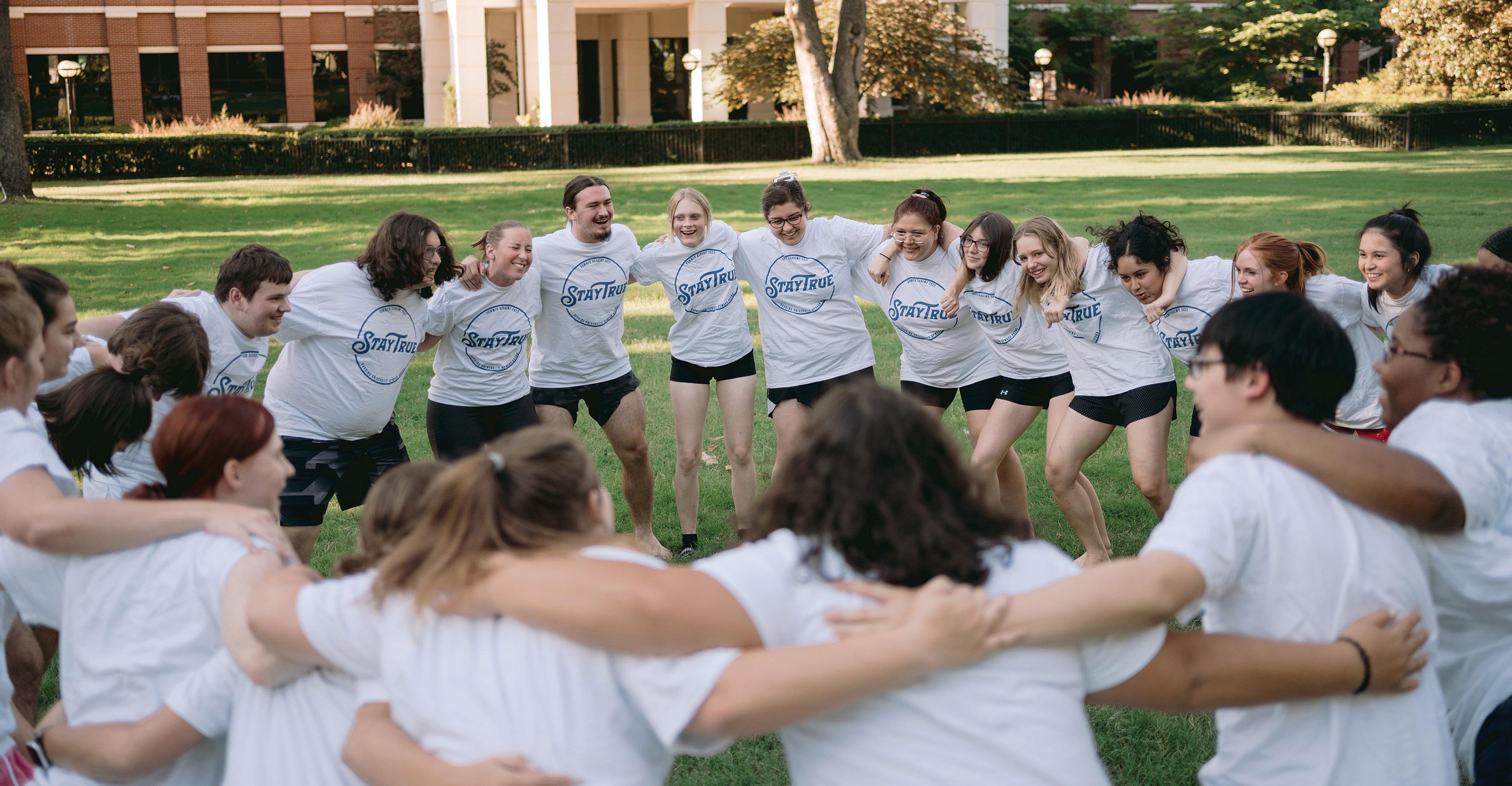
“Eighty-two percent of our students would be the first person in their family to go to college and come from lowerincome households,” O’Brian said. “So part of our job is to help get them into college, but to me, my favorite part of my job is helping them become the very best version of themselves.”
The Upward Bound program helps high school students, primarily those from disadvantaged backgrounds, by giving them the tools necessary to pursue

a university degree. During the school year, this takes the form of 12 Saturday sessions in which students receive ACT prep, tutoring and lunch in the Harding cafeteria. During the summer, Upward Bound’s 65 students will attend a sixweek summer camp on Harding’s campus designed to mimic the college experience.
Junior Allie Nesbitt has worked the summer academy for the past two summers and said she always finds herself inspired by the kids in the program.
“I really enjoy it,” Nesbitt said. “It doesn’t feel like a job to me. What’s so cool to me about these kids is that they choose to sacrifice most of their Saturdays, and six weeks of their summer, to come and take classes to achieve their goals.”
One of those who has gone through the Upward Bound program and now
attends Harding is freshman Daicy Martinez. The examples she gave highlighted not only how Upward Bound helped her get into college, but how to succeed there as well.
“One of the biggest impacts was the preparatory classes they offer for the ACT,” Martinez said. “We learn how to tackle each section of the ACT, and that truly helps us succeed. Due to that prep, I made a 31 on the ACT and was nominated and picked for the Trustee Scholarship at Harding. I am eternally grateful to have had the opportunity to be in Upward Bound, and I would do it a million times again.”
Besides the academic impacts, Martinez also noted that Upward Bound gave her something more valuable: an encouraging and intentional community.
“The program gave me a second community that encouraged and supported me from day one,” Martinez said. “Through summer academy, I strengthened relationships with people I already knew, and I met a ton of people that I still keep in touch with now that I’m out of the program.”
O’Brian echoed the same sentiment — while Upward Bound does help students with academics and motivation, the family-oriented feel is what truly makes the program special.
“A lot of our kids will text us all the time and talk to us all the time,” O’Brian said. “And so we get to navigate these really tumultuous teenage years alongside them. We are truly a family, and I love that so much.”
ARcare opens facility in Searcy
EMILY STINNET guest writer
ARcare will use the Downtown Church of Christ building to start a new daycare that focuses on children from low-income families.
ARcare is a community health provider based in Augusta, Arkansas. Its Center for Education and Wellness focuses on childhood education. It is a magnet for foster children and extends into the community beyond primary care.

Searcy is known for being a “daycare desert,” meaning there are not enough daycare options for the number of children who need supervision during the daytime. Many of these families are foster families with “vouchers,” receiving funding from the government for children to attend daycare.
Jennifer Mills, the family and children's minister at Downtown,
recognized this need in Searcy and saw the opportunity for the Downtown building to be used. Downtown renovated their children's wing in 2018 to accommodate the growth of the church and to prepare for future opportunities of building use. She said they are blessed with the state-of-the-art facility but were wary of how often it sat empty. In spring 2022, after various conversations with leaders in the community, Mills reached out to ARcare to invite them into Downtown’s space.
“We think there is no better way for us to be obedient and to be in relationship and to make disciple-makers of others, than to minister to the least of these,” Mills said.
Usually, the ratio of children at an ARcare facility is one-third voucher children, one-third private pay and one-third employee children. Mills
said she hopes the Downtown facility will be able to host two-thirds or three-fourths of “voucher” children so daycare can become more accessible for foster families in White County.
Winston Collier, the chief legal officer at ARcare, said about $1.5 million has been allocated for this specific partnership.
The money will help move forward the process of hiring staff and updating a few facility needs at Downtown. He said he looks forward to this collaboration that is a model to White County of serving the people who need it most.
“When community partners come together,
each bringing their own skill set to benefit the lives of children that might not otherwise have that opportunity, it brings all of us such great joy to see that happen,” Collier said.

Shanna Jones,an instructor of family and consumer sciences, said she is excited for Harding students to connect with the new partnership. In the future, ARcare and Downtown hope to invite Harding students from different departments such as child life, communication sciences and disorders, and social work for observation hours or internships.
“It's really cool that three totally different entities are working together to make something happen that they all wanted to happen, but none of them could do it by themselves,” Jones said. Starting in January, Mills plans to open the daycare with 75 children ranging from toddlers to kindergarten.
PHOTO BY MADISON MEYER
Upward Bound students pump each other up for a game of paint football on the front lawn on June 28. Upward Bound recruited high school students from White and Woodruff counties in an effort to build motivation for students to seek higher education.
Upward Bound students participate in an etiquette banquet in the Harding University Cone Chapel on July 6. The program impacts much more than academics for those students who attend.
PHOTOs COURTESY OF ASHEL PARSONS
PHOTO COURTESY OF ASHEL PARSONS
Jennifer Mills tours the new ARcare facility at Downtown Church of Christ on Aug. 31. Downtown and ARCare partnered together to create a daycare center specifically for children from low-income families.
Friday, September 9, 20222B COMMUNITY
New representatives join SA
WATKINS KELLY guest writer
Student Association (SA) elections provided an opportunity for members of the student body to make their voices heard and to support peers who shared similar positions on how to improve campus life.

The majority of SA offices were elected in the final weeks of the spring semester. However, as in previous fall semesters, the freshman representatives were chosen by their class within their first few weeks on campus. SA President Meg Sledge said adding freshmen to the organization brings energy and excitement for the upcoming year.
“Freshman representatives step onto campus, and they see lots of possibilities,” Sledge said. “In addition to representing their class, they can bring in their own fresh ideas, and that is really exciting.”
In chapel on Sep. 1, it was announced that Grayson Hume had won the race for freshman male representative and that a runoff would take place for freshman female representative. After the runoff vote Sep. 3, it was decided that Elizabeth Brown would serve as the freshman female representative.
Hume said he decided to run for the position because he saw an opportunity to utilize his spiritual gifts of leadership and communication. He views the experience as a time to walk alongside his peers in service, as well as an opportunity to grow.
“I’ve only been here a few weeks on campus,” Hume said. “Joining the SA is an opportunity to be influenced and poured into by upperclassmen, and I think that will change my whole perspective.”
In addition to the freshman representatives, students from all classes voted for a second international
representative. Previously, only one international representative served in the SA. However, a second was added this year to increase the voice of international students, Sledge said.
“With an additional representative, we also have the incredible opportunity to add an international students committee,” Sledge said. “The new representative will be able to look to this group and directly address their wants and needs.”
Sophomore Hector Tabora was chosen as the second international representative and will serve alongside junior Emeth Camano. Tabora said though he and Camano are both international students, they bring unique experiences that will help them during their time in the SA. Ultimately, he hopes to be a part of bringing together the Harding community.
Out-of-this-world research
“Being an international student, sometimes it is hard to connect with people,” Tabora said. “I was very lucky because I was able to meet and connect with other international students early on, and I want other people to have a similar experience.”
Sledge said she is excited for the new additions to the SA and feels that now that the group is complete, they can fully tackle their goals for this year.
“Working out of our theme this year and the umbrella of ‘Telling the Story,’ the representatives go out on campus and make decisions based on student voice and the administration,” Sledge said. “It wouldn’t be possible to have the Student Association we have without the representatives that we have.”
Will Waldron defends doctoral dissertation with data from Hubble telescope
EMMA JONES editor-in-chief
Dr. Will Waldron, an instructor of engineering and physics, recently defended his doctoral dissertation, which regarded information he researched using broadband data from the NASA Hubble Space Telescope.
In his dissertation, which was titled “A pipeline to study Hubble Space Telescope ACS/WFC3 data and examples of its applications,” Waldron researched star formation properties on stellar clusters in other galaxies, leading to the ability to constrain stellar mass, age and star formation rate within tails of other galaxies. Waldron said in simpler terms, his thesis focused on studying how galaxies evolve.
“What I told people is I just got to look at pretty images from Hubble over the course of my graduate academic career, which is a pretty sweet deal,” Waldron said.
Waldron earned his doctorate from the University of Alabama in Huntsville,
where he started his research using Hubble data while he was a graduate student. At Harding, he teaches several physics courses and the astronomy course.

“Will has worked diligently the last few years to make substantive contributions to his field while also teaching full time,” Dr. Steven Barber, associate professor of physics, said. “I am excited for the opportunities Harding physics students will have to join Dr. Waldron in future research, especially as many of them express an interest in astrophysics.”
Junior Callie Williams, a medical laboratory sciences major, took both semesters of general physics with Waldron. She said Waldron is a professor who teaches his lessons well, but also has a lot of fun doing it.
“He always referenced space in class, and made lots of Star Wars jokes,” Williams said. “He taught well, but he also created community well.”
Waldron said though most children go through a phase of being fascinated with space, he never grew out of his, and that is what inspired him to go into astrophysics.
“I fell in love with the sky when I was about five years old, and just never left that phase,” Waldron said. “I knew I wanted to study all things space so when that came to choosing a degree at Harding, that led me to astrophysics. My love for space led

‘Everybody deserves a voice’
BEN LANE sports editor
to me eventually studying it and doing it for a career.”
As for future research, Waldron said he had a few ideas for potential projects, but he plans to take a short break from research to rest after earning his doctorate.
Lynley Eller returns to Harding after traumatic brain injury
Sophomore Lynley Eller has returned to campus and is taking the semester in stride after a traumatic brain injury from a car crash in November 2021.
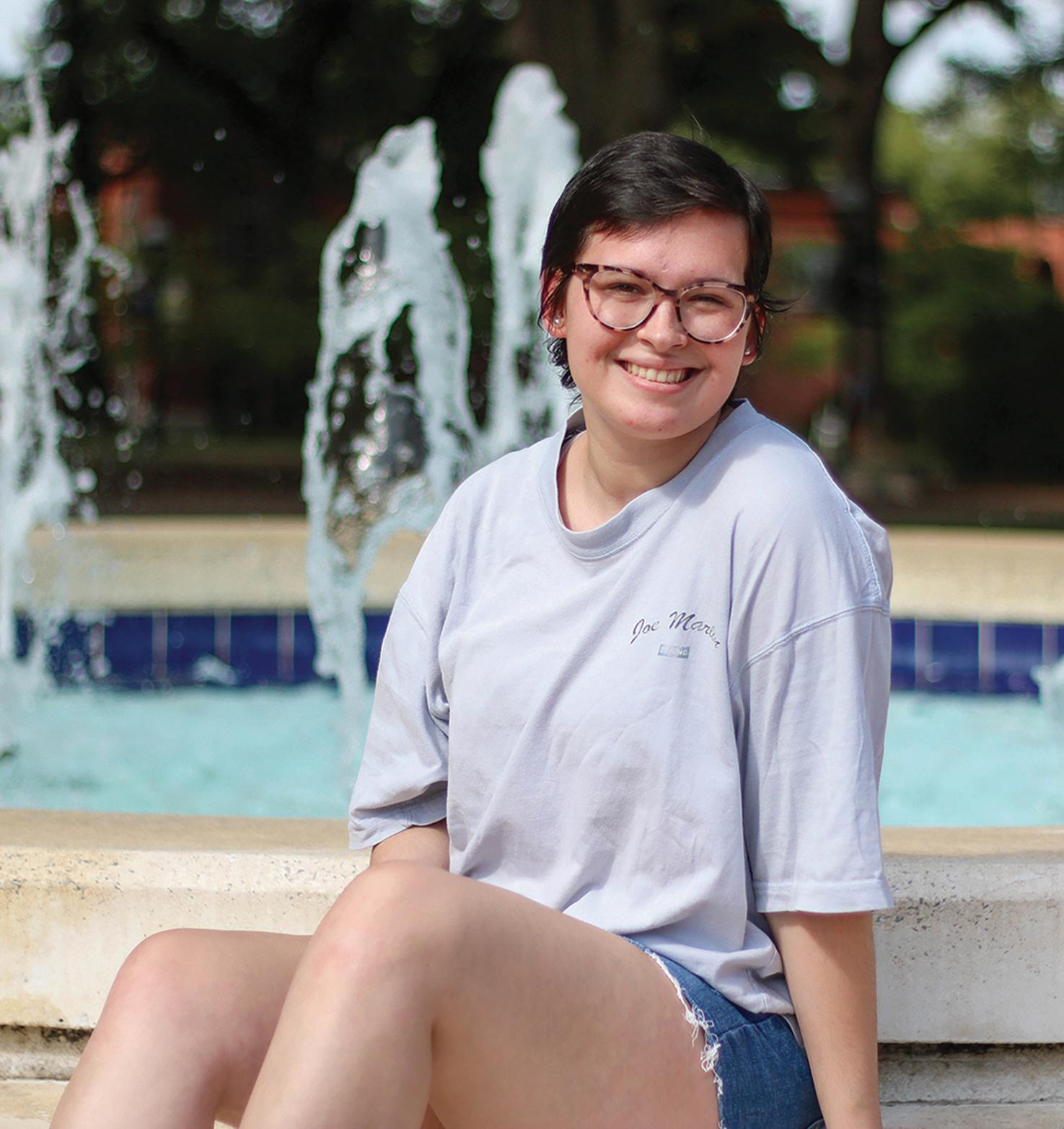
Eller said her return has been an amazing experience that she has “loved every single second of.” Before her accident, Eller said she developed many meaningful relationships on campus. To her, passing acknowledgements from friends felt genuine and caring, but she worried she might lose that connection when she came back. Since returning, she found the same meaningful relationships remained on campus.
“The people that I care most about, besides my family, are here at school,” Eller said. “I’m so thankful to, somehow, make it so fast to this point.”
Eller’s prognosis after the car crash was dim. The medical staff did not expect her to survive the night or let alone the week. However, Eller defied the odds. She continues to defy the odds by attending school nine months after her injury, an accomplishment not thought possible in the initial stages of her recovery. She credits her ability to attend school to her speech pathologist, who rehabilitated her. The pathologist “cared about [her] as a human being and knew where [she] was coming from,” Eller said.
Coincidentally, Eller’s major is communication sciences and disorders, which is precisely the field she needed therapy for. Her experience with her
therapist, along with her inability to speak immediately following her accident, compounded her desire to work in speech pathology.
“Hopefully, I can [help] someone else because everybody deserves a voice,” Eller said. “Whether that’s spoken, written, sign language, anything. So giving [a patient] their voice back is something that I’m very passionate about.”
Dr. Jennifer Fisher, associate professor of communication sciences and disorders, said Eller’s presence is a happy surprise and a bright light in the classroom. Fisher said Eller’s presence may benefit other communication sciences and disorders students because they are closely connected with an example of potential patients.
“I always want to remind students in my class that once they’ve decided on this major and they’re taking upper level courses, the learning is not about them anymore,” Fisher said. “It’s about their patients.”
Sophomore Julia Jenkins said it has been incredible to have Eller back on campus.
“It’s such an evident thing when someone like Lynley, being her joyful, silly, wonderful self isn’t on campus,” Jenkins said. “It’s a presence that you feel is not here anymore. [Now] it’s just like a little piece of light is back where it should be.”
Editor’s Note: Sources in this article were given permission from Eller to comment.
Candidates running for SA freshman representative participate in a debate on Aug. 30. Freshman Elizabeth Brown and freshman Grayson Hume were selected as freshman representatives, and sophomore Hector Tabora was selected as a second international representative.
Photo by MADISON MEYER
Lynley Eller sits at the fountain outside the Anthony-Wright Administration Building on Sept. 1. Eller returned to campus to resume classes after suffering a traumatic brain injury in a car accident in November 2021.
Photo by BALAZS BALASSA
Dr. Will Waldron displays his research in his office in the Pryor-England Sci ence Center on Sept. 1. Waldron completed his doctoral dissertation using data gathered from the Hubble Telescope.
Photo by MADISON MEYER
Graphic by COOPER TURMAN
TheLink.Harding.edu FEATURES 3B
Social clubs hold downtown concert
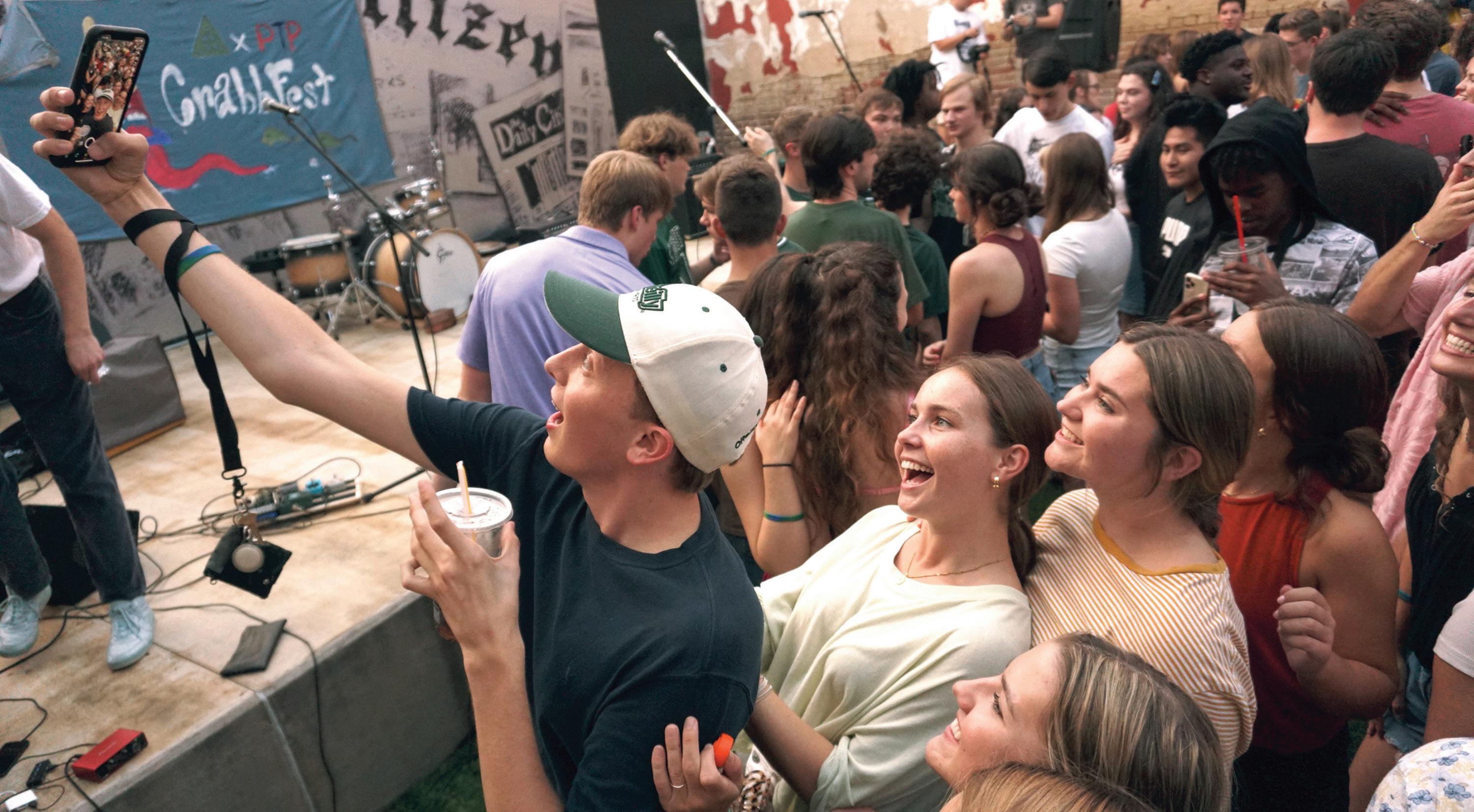
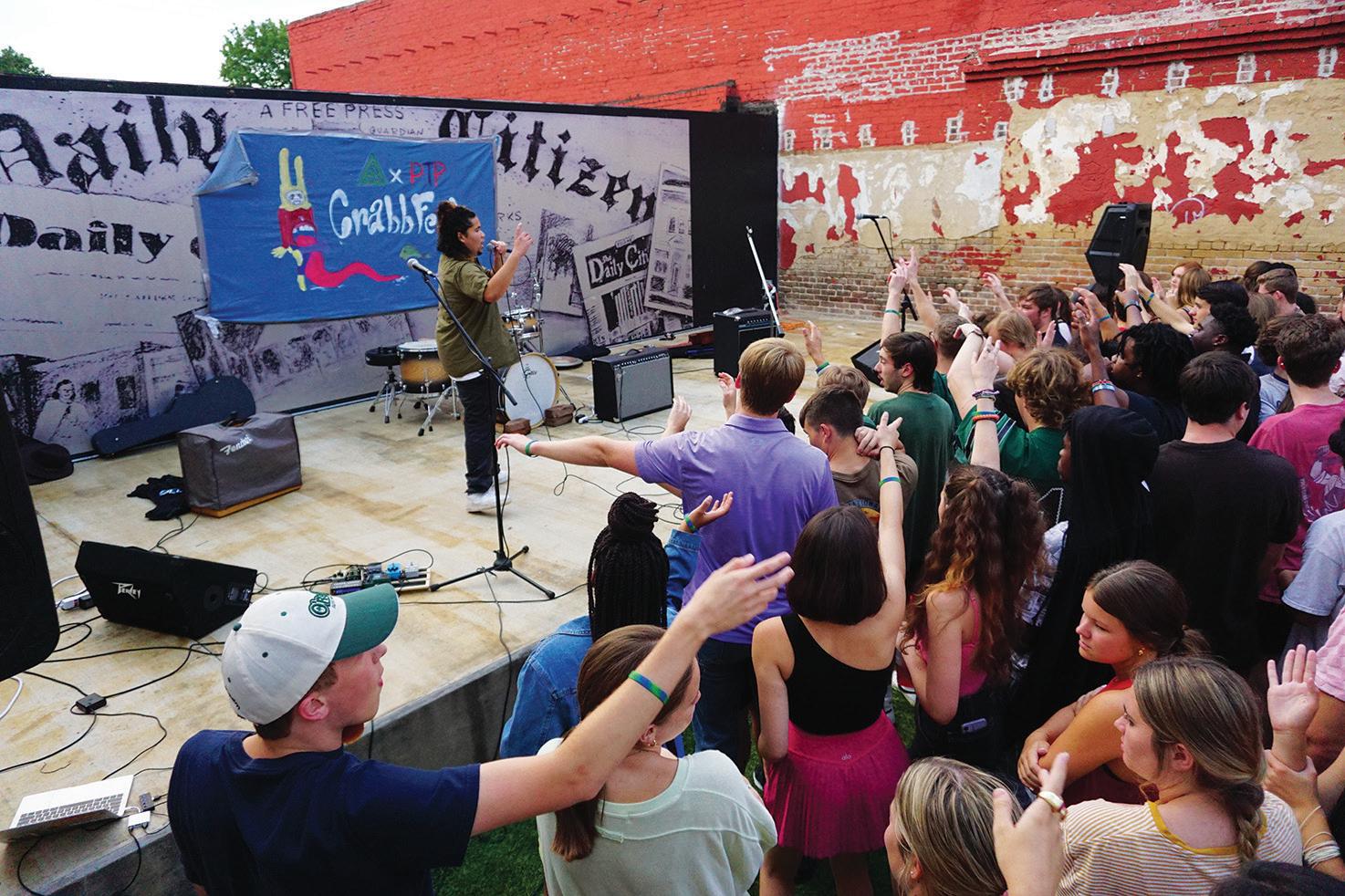

The two social clubs Knights and Pi Theta Phi worked together on Sep. 2 to put on a fundraising concert called “CrabbFest” in the name of Cory Crabb, a Harding student who is unable to be on campus this semester due to medical complications. He is a member of Knights and a beau for Pi Theta Phi, which is what set this collaboration into motion.
Senior Jackson Keller, the treasurer for Knights and part-time bouncer for the event, reported that the concert raised about $3,400 in ticket and t-shirt sales. They sold around 400 tickets in the form of wristbands with “CRABBFEST 2022” printed on them. The t-shirts sold at the event were designed by Knights member Jobin Butterfield.
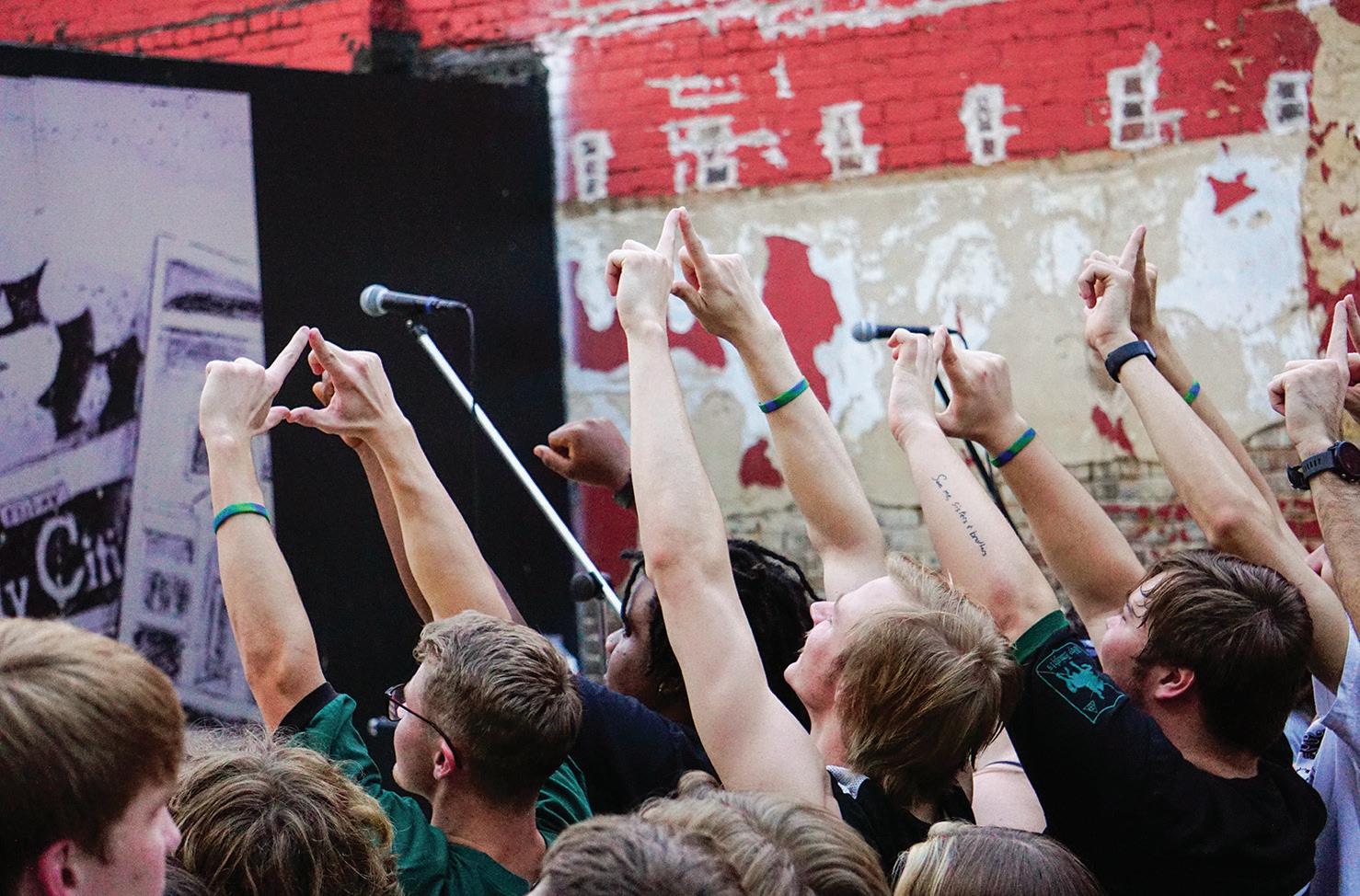
The proceeds raised at the concert are being donated to Dry Bones Denver per Crabb’s request; he had plans to work with them over the summer and wanted to give back, Keller explained.
The nonprofit organization “is a longstanding community of support among Denver’s unhoused teens and young adults,” according to the ministry’s website. “Alongside helping to meet emotional, spiritual, and physical needs, [their] true work is practicing the way of Jesus through building ongoing relationships that remind the invisible among us of their immeasurable worth.”
When asked about the motivation for
the event, senior Blake Dale, president of Knights, said that they “wanted to do something fun in honor of Cory” because Cory is usually the one bringing the fun. This was the second semester kickoff fundraising concert that Knights has put on. The first one took place last fall in support of White County Domestic Violence Prevention Inc. Since this was the second annual concert, Dale said the goal was “to kick off the school year with a sick concert because [they] had a sweet one last year.”
Opening the concert was the solo artist T!AN, a former Harding student now living in New York. He was able to perform a few of his original songs, and the crowd was eating it up. T!AN also featured senior Knights member Adam Dawidow on one of his songs during the set. Dawidow took this opportunity to show off his stellar rap and dance skills to the amazement of the crowd.
Headlining the event was the band Sparky & The Hills, who originate from Columbus, Ohio. Band member Eric Johnson is a Harding and Knights alum, which is what brought them to Searcy. A few songs into their set, Crabb was brought on stage via FaceTime, and the crowd cheered louder than they had all night.
Crabb was active on social media throughout the night responding to concert-goers and friends tagging him on Instagram. It was evident that night that campus misses Crabb.
Transfer student breaks the ice by going viral
A Harding student has gone viral on TikTok for a series of videos filmed in her dorm room, with a video reaching over 4 million views.
Sophomore transfer student Maggie Tackitt created a TikTok series opening 14 moving out gifts from her mother. Tackitt had never gone to school away from home, and her mother left her small presents to open every day. She made a TikTok for each day and posted it to her account.
“I like making videos,” Tackitt said. “I’ve always liked making videos.”
Before her series went viral, Tackitt had 150 followers. She now has over 13,000 followers. The videos were getting thousands of likes overnight, and people were waiting for the daily videos.
“At that point, I was overwhelmed,” Tackitt said, “but I kept making videos.”
In the process of meeting other students as a transfer, Tackitt met people who had already seen, liked or saved her videos. She used her viral videos as an icebreaker while meeting people on campus.
“It’s kind of a lot of pressure,” Tackitt said, “because now I feel like I have to find something else to do. I mean obviously I don’t need their attention, but it made people really happy, and I need to keep that up, I think.”
Tackitt’s roommate, junior transfer Kaycee Hatley, said Tackitt was completely surprised by her mother’s gift, and she thinks that was one of the things that made it a really good gift.
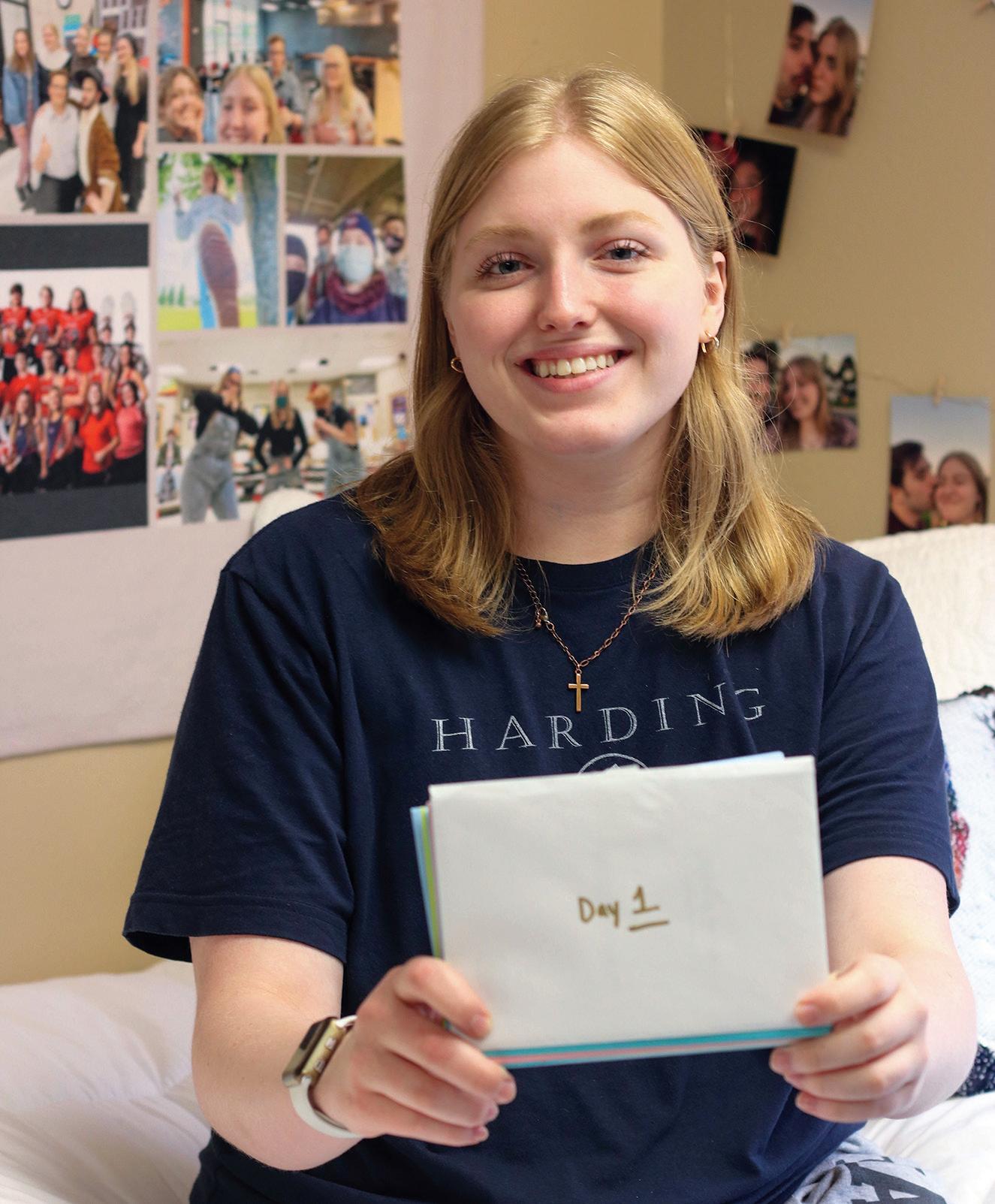
“The first couple of weeks away from home in a completely new environment can be pretty overwhelming,” Hatley said. “Her mom clearly foresaw the challenges she would face as she adjusted, so she put in the effort to give her daughter something to look forward to each day when she woke up.”
Hatley said she enjoyed the excitement of a new gift each morning and the progress of the TikTok series. She said the majority of people had supportive comments about the videos.
Lori Sloan, assistant professor of communication, said bad things go viral easily and can ruin a person’s reputation. She said she was glad Tackitt’s viral series was a happy thing.
“I’m proud that it’s something that people can say, ‘This is a girl from Harding,’” Sloan said, “that it’s something sweet and fun that her mom did for her and that it isn’t something bad.”
STACY ROIBAL beat reporter
Knights and Pi Theta Phi social clubs hosted CrabbFest in honor of Harding student Cory Crabb in Downtown Searcy on Sept 2. Sparky and the Hills and T!AN performed at the concert.
MAGGIE SAMPLES lifestyle editor
Photo by BALAZS BALASSA
Maggie Tackitt displays letters from her mom in her dorm on Sept 5. Tackitt went viral by making TikTok videos of the care packages she received from her mom.
Photos by MACY COX
Friday, August 30, 20194B LIFESTYLE Friday, September 9, 2022
